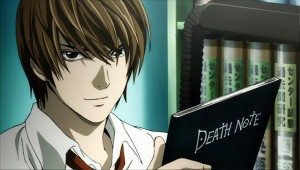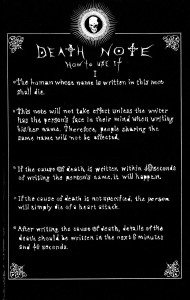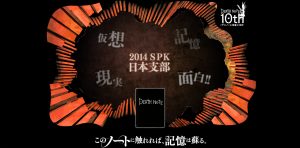Anime Series Blog: Death Note
Imagine a world not entirely dissimilar from our own, a landscape darkened under the prevalent shadow of crime and corruption. A world where the good suffer for the sins of evildoers, a world that is rotting. The sheer downward slope stretches out before our eyes, and mankind balances on the brink, primed for the fall. Or so it would seem. From the open clouds an obsidian notebook drops to the ground, one with the terrible power to alter the fate of the world. The Death Note.
“The human whose name is written in this note shall die” – Death Note Rule #1
There’s always a ritual that accompanies the viewing of a show such as this, a sequence of actions that feel somehow necessary to pay proper homage to both creators and creation. Disk carefully removed from box and inserted into tray, the lights must then be extinguished, curtains drawn, the outside world severed so that all attentions are devoted to one sole task – basking in the breathtaking artistry of a modern masterpiece.
As the intro fades out to an angelic, Christian-esque male chorus rising atop an animated vision of the barren planes of the Shinigami Realm, a shiver runs down my spine. Anybody who knows my personal habits will recognise that very rarely will I devote myself twice over to a series, yet this will mark the fifth time I have watched Death Note – and it certainly will not be the last. As my first (of many) animated series reviews, there was little choice but to review something outstanding. If I’ve yet to convince you that you should be sprinting to HMV’s anime section to buy the box set right now, not wasting your time reading this article, then read on. I’ll make an addict out of you yet.
Story
The series, based on a manga of the same name, follows Light Yagami, a Japanese high school student disillusioned with the world around him, festering in crime and corruption, and who, purely by chance, stumbles upon the Death Note, a notebook which can kill any whose names are written on its pages. Believing it to be an intrinsic prank, Light is initially sceptical, until witnessing first-hand the Death Note’s power. Meanwhile, the Death Note was purposefully dropped by shinigami (God of Death) Ryuk, aiming to dispel his own boredom by releasing it into the human world. By the time Ryuk descends from the Shinigami Realm to seek out the notebook’s new owner, Light has utilised the notebook to erase the world’s most infamous criminals in a quest to purge it of evil and create a purified Utopia. Alongside an almost childlike vision of justice, Light develops a delusionary belief unlike any other – a god complex.
The nature of the anime is such that to attempt an accurate, detailed summary of its story past the initial episode would be both impossible to fit into a review and riddled with spoilers that would categorically ruin the series. Without risk of spoiling the plot, however, born from Light’s subsequent journey to rid the world of sin is a complex moralistic struggle, that draws upon both logical and philosophical aspects of debate, and which is never truly put to rest. The series also relies on the age-old technique of parallelisms to forward its plotline and draw up some interesting and at times refreshingly comic ironicities. It certainly isn’t your average shounen show, yet it does perfectly what so many fail to – after a suspenseful first ten or more episodes of juicy plot-heavy scenarios, at the opportune moment it strikes with an unlikely (and so all-the-more hilarious) burst of comedy. Up to the neck in intricate mind games and strategic schemes from beginning to end, Death Note cannot disappoint. Among many, it’s believed that anime ends where elegance begin, and, true, we’ve enough crappy harems to sink a Japanese battleship, but this here, what you’re stepping into, is the big leagues.
 Characters
Characters
No story would triumph without a single interesting characters, and yet here, too, Death Note flourishes. Episode upon episode, exceptional character development shines throughout, even for minor sub-characters. Clearly co-creators Tsugumi Ohba and Takeshi Obata and director Tetsuro Araki were of like mind in asserting (as they should) that multi-dimensionality is a requirement when striving for anything above average quality. I personally feel cheated if my protagonist is as soggy as milky Weetabix. Moreover you’ll find no extraneous excess here – each character introduced has a clear purpose to serve, which they do with precision, leaving an audience satisfied that the writers’ attention never shifted from the good stuff, the overall plotline.
Light could not have been written with more conviction nor clearer intent. You may want to hate him for being an opportunistic megalomaniac, but just can’t. He’s Mr Honour Student, intelligent, gorgeous, wondrously cocky and far too cool and calculating to elude an audience’s admiration and respect. And with this, the series challenges us in ways we never thought it could; it pulls the moralistic debate from the screen right into our own laps. Despite our public disinclination to agree to mass-murder, we find ourselves questioning our own shaky principles when it dawns on us that we want Light to be successful. We want him to become God and wipe out sin – oh, it’s just too easy to fall into the trap. It is this which can make us somewhat uncomfortable, as we realise that Light is a shade of us all, demonstrating how easily intense morality can be corrupted, and how despite our outward beliefs, our deepest desires may not be far from heretical.
Animation
Though I rarely fret about animation quality (as I’m as much used to the 90s classics as the crisp 21st century shows), when Death Note was released 8 years ago, it boasted some of the best animation to date. An impressive and unique shading technique combined with the more traditional style of drawing to create a look and feel that both stayed true to the typical appearance of anime and achieved a realism that reflected Death Note’s mature themes. Camera angles and lighting succeed, when charged, to advance the anime’s overarching themes by alternating casting techniques between celestial visions and dystopian landscapes.
Music
Countless reviews place blame on Death Note’s music scores as the weak point of the anime, dragging it down from a perfect 10. I disagree. Similarly to the animation, care has been extended to ensure that overall, the gritty soundtrack resonates with the mood of the dark world in which the anime takes place. Character themes in particular have been innovatively orchestrated and accentuate the dramatic scenes when played. As for openings and endings, I find no major fault. The sublime first intro by Nightmare, aptly titled ‘The World’ unleashes heaven-splitting chords worthy of an enthusiastic head bang to accompany metaphorical Christian parodies of the forbidden fruit and Michelangelo’s The Creation of Adam. I’m partial to a death metal track on occasion, so Maximum the Hormone, which took over for Nightmare, did exceptionally to capture the hysteria that begins to emerge during the second series.
Subs vs. Dubs
From experience and without exception, the dubbed version of an anime pales when compared with the subtitled Japanese. In fact, I may not write this segment again, because my advice will remain the same. Subtitles. Always, always, subtitles. While the dubbing actors for Death Note hardly decimated the show’s credibility, they certainly didn’t enhance it, either, as many of the voices ill-suit the personalities of their respective characters. Light’s voice, the most imperative voice to cast correctly, sounds far more like the whining babble of a fourteen-year-old boy than the methodical, villainous baritone of an adult male we receive in the Japanese version. As a personal opinion, the characters just feel downgraded from a vibrant set of individuals to an irritating bundle of ham American actors.
It’s More’s Utopian dilemma in full 21st century glory. Such a densely-packed, fast-paced story is rarely seen in an animated series, and with thankfully none of those infuriating filler episodes the Japanese like so much, Death Note continues its dizzying momentum all the way to its climax. When you finally pull up the bar, get off the roller-coaster and set two trembling feet on the ground, it only takes a moment of regaining balance until you’re back at the queue’s end to experience it again. And again. And again.
Right now would be the optimum time to relive the series or experience it for the first time. In February a new website launched to mark the tenth year anniversary of the manga, and with it, a countdown timer appeared, at which fans could only speculate that a reboot was in the works. Since then, the website has announced a live Death Note game produced by SCRAP that will take place in Tokyo and Osaka later this year. A smart phone escape game is also being released, although players are required to solve a riddle on the anniversary website to find a password that unlocks the game. Finally, a 10th year anniversary edition of the manga, a republishing of the original, has been released with goodies, for a limited time. So far the team behind this have only revealed that there are no plans to reboot the manga ‘at the moment,’ a promising declaration for the future. For now, Hollywood has bought the rights to the story and are apparently contemplating a Western remake, so fingers crossed.
Death Note truly is a one-of-a-kind series, paramount to pretty much anything you will ever see again in your lifetime, and utterly timeless. If you haven’t watched the first episode, stop reading and do it. Now. You will not be disappointed. If you only ever watch one anime in your lifetime, make this it. Only one possible downside exists with a series this flawless – once you’ve watched it, you’ll never find anything that exceeds it.



Comments